Abstract
The activities of key C4 enzymes in gel-filtered, whole-leaf extracts and the photosynthetic characteristics for reciprocal F1 hybrids of Flaveria pringlei (C3) and F. brownii (C4-like species) were measured to determine whether any inherited C4-photosynthetic traits are responsible for their reduced CO2 compensation concentration values (AS Holaday, S Talkmitt, ME Doohan Plant Sci 41: 31-39). The activities of phosphoenolpyruvate carboxylase, pyruvate, orthophosphate dikinase, and NADP-malic enzyme (ME) for the reciprocal hybrids are only about 7 to 17% of those for F. brownii, but are three- to fivefold greater than the activities for F. pringlei. The low activities of these enzymes in the hybrids appear to be the result of a partial dominance of F. pringlei genes over certain F. brownii genes. However, no such dominance occurs with respect to the expression of genes for NADP-malate dehydrogenase, which is as active in the hybrids as in F. brownii. In contrast to the situation with the enzymes above, cytoplasmic factors appear to determine the inheritance of NAD-ME. The NAD-ME activity in each hybrid is comparable to that in the respective maternal parent. Pulse-chase 14CO2 incorporation analyses at ambient CO2 levels indicate that the hybrids initially assimilate 7 to 9% of the total assimilated CO2 into C4 acids as compared to 3.5% for F. pringlei. In the hybrids, the percentage of 14C in malate decreases from an average of 6.5 to 2.1% after a 60-second chase in 12CO2/air. However, this apparent C4-cycle activity is too limited or inefficient to substantially alter CO2 exchange from that in F. pringlei, since the values of net photosynthesis and O2 inhibition of photosynthesis are similar for the hybrids and F. pringlei. Also, the ratio of the internal to the external CO2 concentration and the initial slopes of the plot of CO2 concentration versus net photosynthesis are essentially the same for the hybrids and F. pringlei. At 45 micromoles CO2 per mole and 0.21 mole O2 per mole, the hybrids assimilate nearly fivefold more CO2 into C4 acids than does F. pringlei. Some turnover of the malate pool occurs in the hybrids, but the labelling of the photorespiratory metabolites, glycine and serine, is the same in these plants as it is in F. pringlei. Thus, although limited C4-acid metabolism may operate in the hybrids, we conclude that it is not effective in altering O2 inhibition of CO2 assimilation. The ability of the hybrids to assimilate more CO2 via phosphoenolpyruvate carboxylase at low levels of CO2 than does F. pringlei may result in an increased rate of reassimilation of photorespiratory CO2 and CO2 compensation concentrations below that of their C3 parent. If the hybrids do possess a limited C4 cycle, it must operate intracellularly. They are not likely to have inherited an intercellular compartmentation of C4 enzymes, since F. brownii has incomplete compartmentation of key C3 and C4 enzymes.
Full text
PDF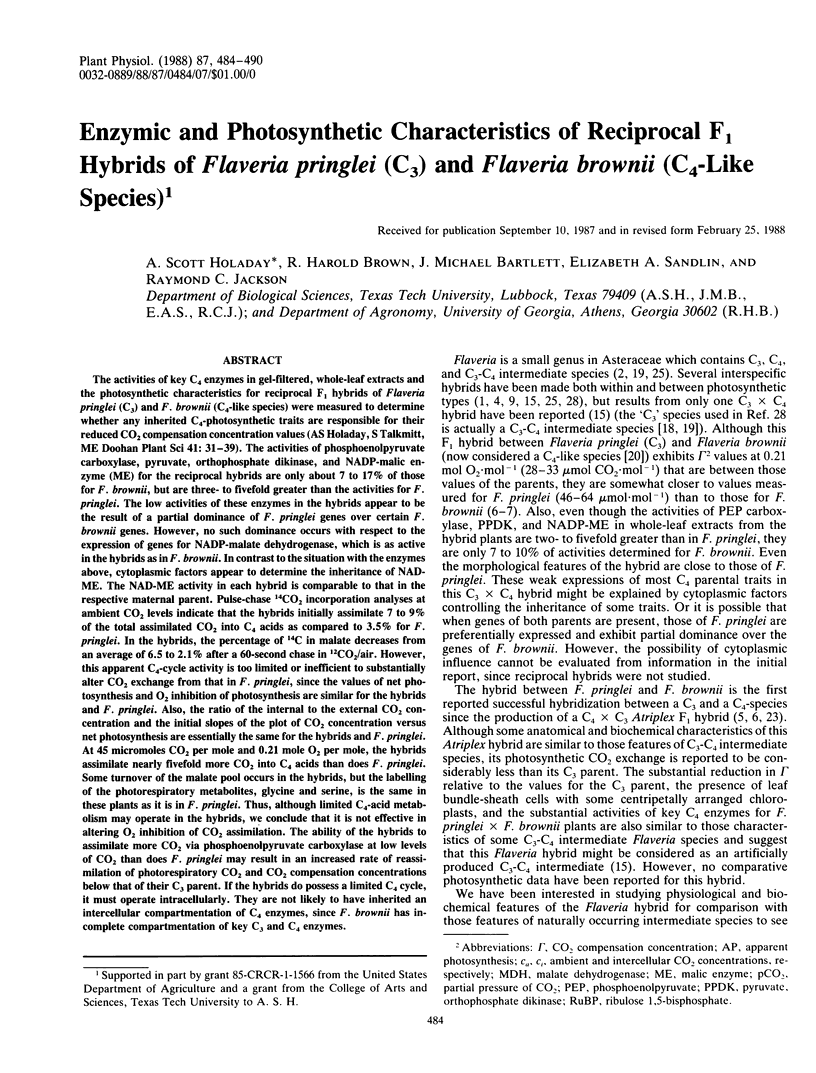

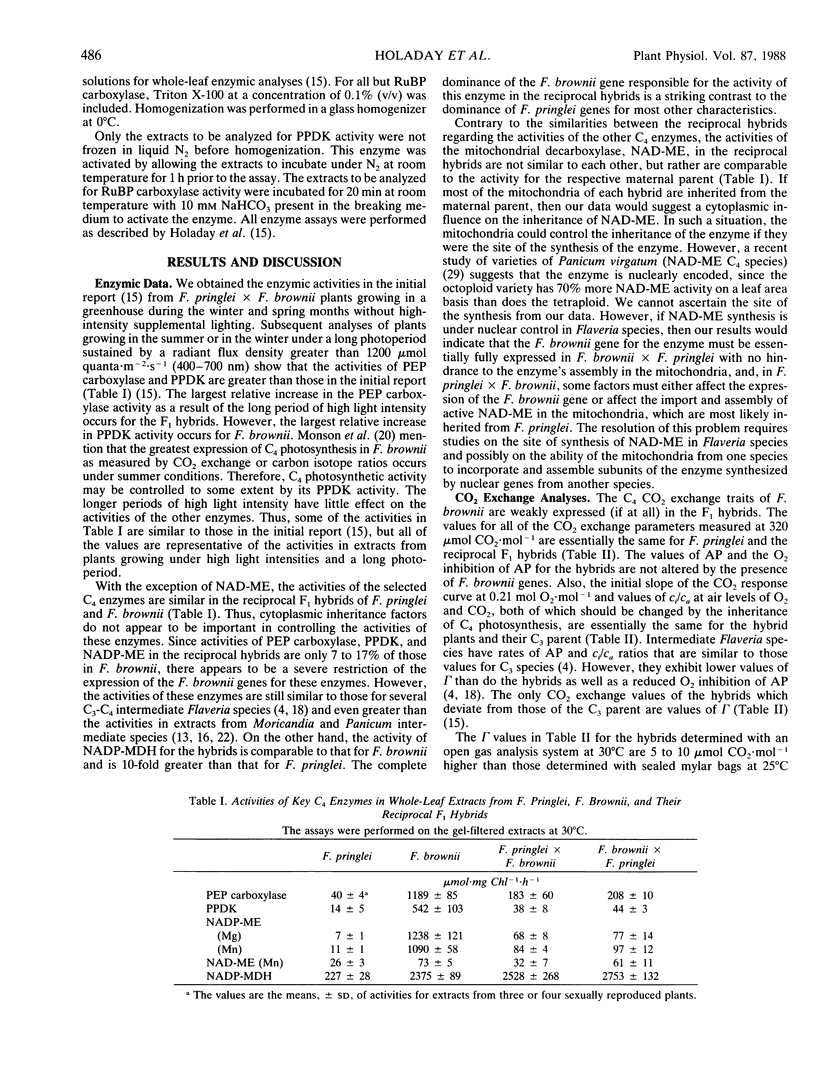
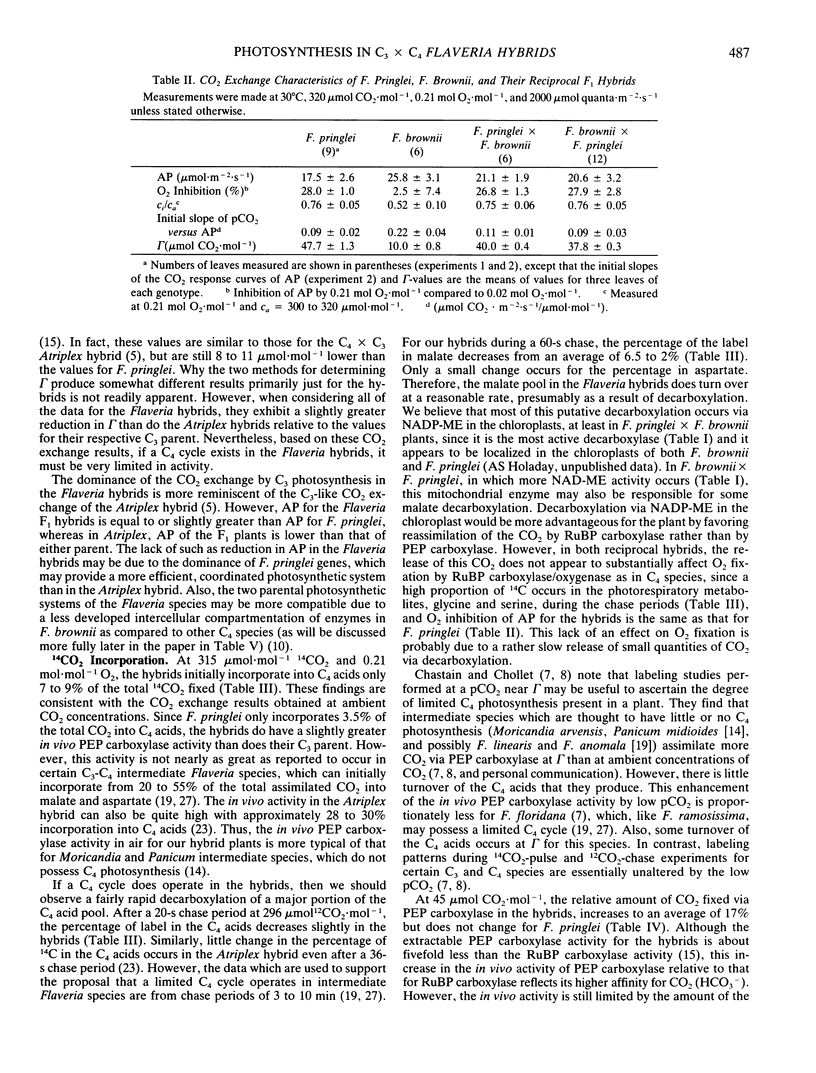
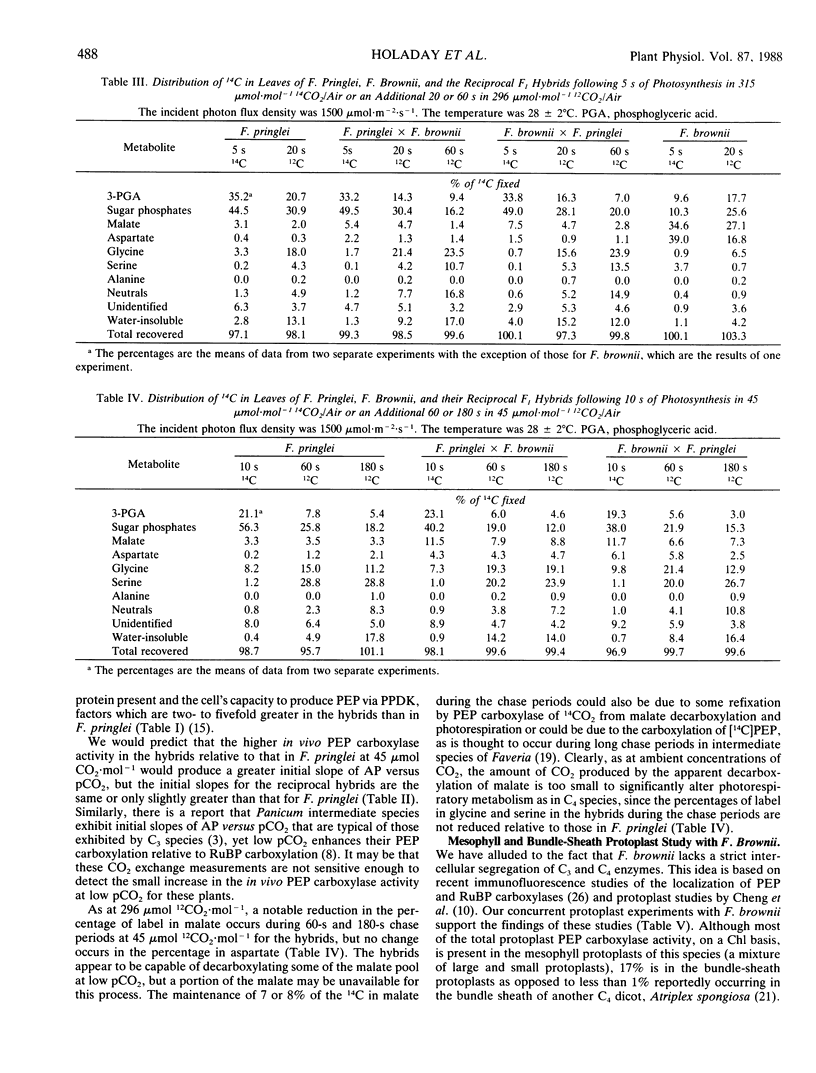
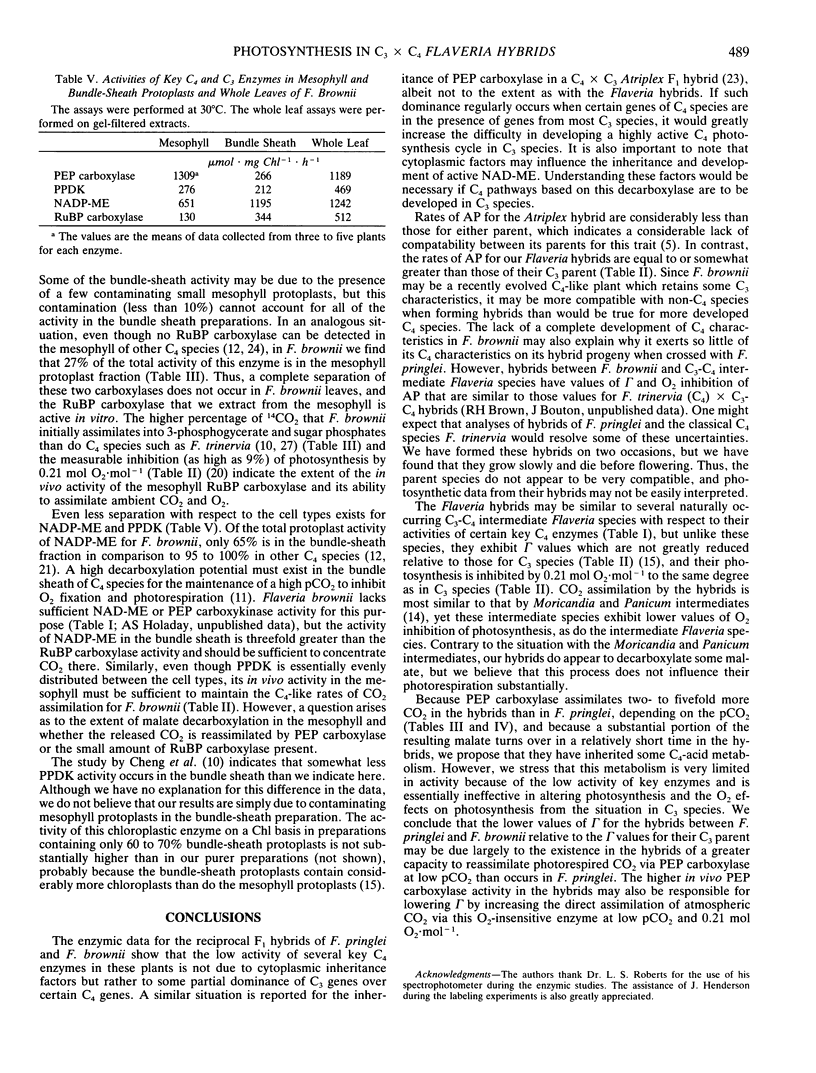
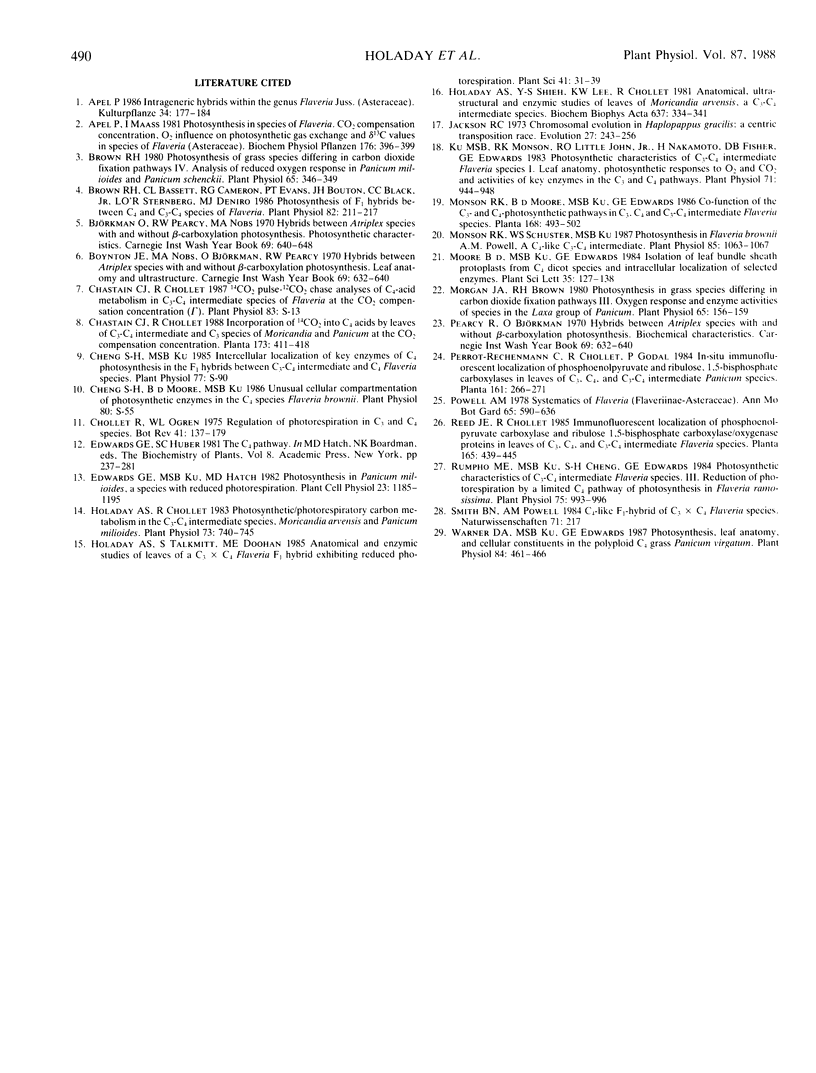
Selected References
These references are in PubMed. This may not be the complete list of references from this article.
- Brown R. H., Bassett C. L., Cameron R. G., Evans P. T., Bouton J. H., Black C. C., Sternberg L. O., Deniro M. J. Photosynthesis of F(1) Hybrids between C(4) and C(3)-C(4) Species of Flaveria. Plant Physiol. 1986 Sep;82(1):211–217. doi: 10.1104/pp.82.1.211. [DOI] [PMC free article] [PubMed] [Google Scholar]
- Brown R. H. Photosynthesis of Grass Species Differing in Carbon Dioxide Fixation Pathways: IV. ANALYSIS OF REDUCED OXYGEN RESPONSE IN PANICUM MILIOIDES AND PANICUM SCHENCKII. Plant Physiol. 1980 Feb;65(2):346–349. doi: 10.1104/pp.65.2.346. [DOI] [PMC free article] [PubMed] [Google Scholar]
- Holaday A. S., Chollet R. Photosynthetic/Photorespiratory Carbon Metabolism in the C(3)-C(4) Intermediate Species, Moricandia arvensis and Panicum milioides. Plant Physiol. 1983 Nov;73(3):740–745. doi: 10.1104/pp.73.3.740. [DOI] [PMC free article] [PubMed] [Google Scholar]
- Ku M. S., Monson R. K., Littlejohn R. O., Nakamoto H., Fisher D. B., Edwards G. E. Photosynthetic Characteristics of C(3)-C(4) Intermediate Flaveria Species : I. Leaf Anatomy, Photosynthetic Responses to O(2) and CO(2), and Activities of Key Enzymes in the C(3) and C(4) Pathways. Plant Physiol. 1983 Apr;71(4):944–948. doi: 10.1104/pp.71.4.944. [DOI] [PMC free article] [PubMed] [Google Scholar]
- Monson R. K., Schuster W. S., Ku M. S. Photosynthesis in Flaveria brownii A.M. Powell : A C(4)-Like C(3)-C(4) Intermediate. Plant Physiol. 1987 Dec;85(4):1063–1067. doi: 10.1104/pp.85.4.1063. [DOI] [PMC free article] [PubMed] [Google Scholar]
- Morgan J. A., Brown R. H. Photosynthesis in Grass Species Differing in Carbon Dioxide Fixation Pathways: III. OXYGEN RESPONSE AND ENZYME ACTIVITIES OF SPECIES IN THE LAXA GROUP OF PANICUM. Plant Physiol. 1980 Jan;65(1):156–159. doi: 10.1104/pp.65.1.156. [DOI] [PMC free article] [PubMed] [Google Scholar]
- Rumpho M. E., Ku M. S., Cheng S. H., Edwards G. E. Photosynthetic Characteristics of C(3)-C(4) Intermediate Flaveria Species : III. Reduction of Photorespiration by a Limited C(4) Pathway of Photosynthesis in Flaveria ramosissima. Plant Physiol. 1984 Aug;75(4):993–996. doi: 10.1104/pp.75.4.993. [DOI] [PMC free article] [PubMed] [Google Scholar]
- Warner D. A., Ku M. S., Edwards G. E. Photosynthesis, Leaf Anatomy, and Cellular Constituents in the Polyploid C(4) Grass Panicum virgatum. Plant Physiol. 1987 Jun;84(2):461–466. doi: 10.1104/pp.84.2.461. [DOI] [PMC free article] [PubMed] [Google Scholar]


